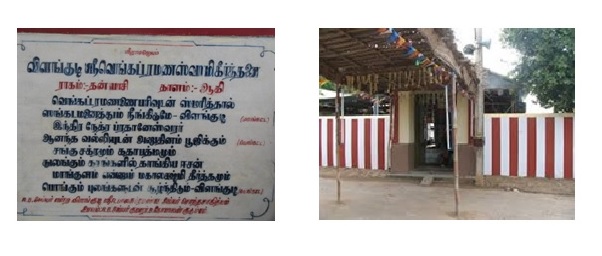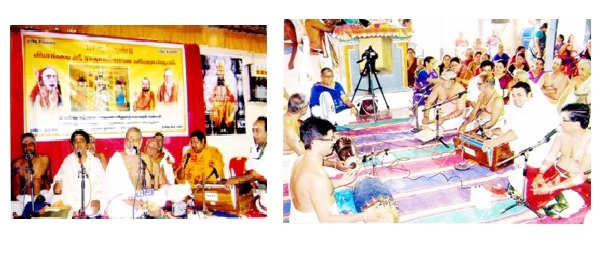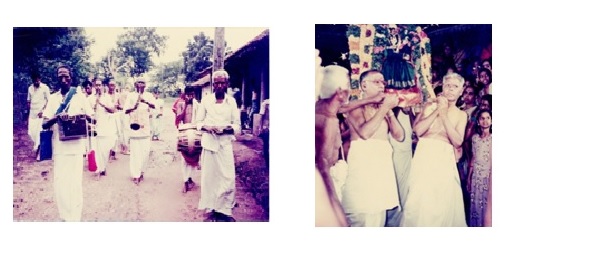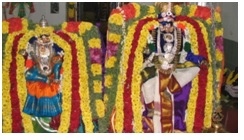In 1899 the Radha Kalyana tradition was started in my (mother’s) village of Vilangudi - among the oldest, if not the oldest such tradition, and, uniquely, held without a break for 120 years. Vilangudi, 10 miles from Kumbakonam, is actually a ‘kuk-gramam’ – a tiny village, literally one Sannathi Street. When my mother was a child in the 1920’s and 30’s, there were 40 houses on the street – there are even fewer now, village population a few hundreds. Remarkably for such a small village, it has the full panoply of temples. There is a small Ganapathi temple, as one enters or exits the village and temples for Mariamman and Ayyanar as well.

The main Perumal temple is that of Sridevi-Bhudevi-Sameda Venkataramana Swamy. The utsava vigrahams are Radha-Rukmani-sameda Krishna. Overlooking the Sannathi Street, the temple is actually very small - literally, a small garba-griham and a mandapam. My mother narrates an anectode: while renovating the temple some decades back, the granite pillars or the roof of the mandapam could not be lifted, but, after Kanchi Mahaperiaval’s visit, miraculously they could! Latest Kumbhabisekam was in 2011 graced by Sri Jayendra Saraswathi Swamigal. At the other end of the Sannathi Street is the Shiva temple – the ‘moolavar’, as spelt out in his inimitable diction by Kanchi Sri Vijayendra Saraswathi Swamigal, is that of ‘Indra-Netra-Pradaneswarar’. Even Lord Indra could be blinded and it was here that Lord Shiva restored Indra’s eyes! The village main pond is nearby.
Evolution of Radha Kalyanam in Vilangudi
The Namasankirtana ‘trimurtis’ are Sri Bodendra Swamigal, Sri Sridhara Ayyaval and Sri Satguru Swamigal, each of whom established a unique tradition. Their mutts are equidistant from Vilangudi, about 10 miles. In 1899, combining these three, a Vilangudi tradition of Radhakalyanam was established by Sri Radhakrishna Bhagavathar. In those days, there were no other escapist entertainments and this provided an opportunity for a wholesome cultural and religious pursuit. Although elements from all the three traditions are incorporated, Vilangudi’s is predominantly Sri Bodendra Swamigal’s. Even today the namasankirtanam on the first evening is by the Swamigal from that mutt, currently, Satguru Sri Kothandarama Swamigal. In the earlier years, it was essentially the local bhagavathars, who participated in the utsavam. Radhakrishna Bhagavathar’s sons, especially, Sri Kalyasundara Bhagavathar, is remembered by my mother as the legend in her younger days. His son, Sri Kalyanasundaram Subramaniam, is now, among the leading organisers of the utsavam and regularly accompanies the current maestro, Sri Udayalur Kalyanarama Bhagavather on mridangam.

As the popularity of Vilangudi Radha Kalyanam grew, Bhagavathars from other villages began participating in it. In recent decades, the star cast is led by Udayalur Dr Kalyanarama Bhagavathar. On both his parent’s side, there have been distinguished artists and he grew up imbibing the best of Kumbakonam-Cauvery culture. He is a stickler for tradition, but, imparts soul to namasankirtanam with an unequalled verve and passion - a combination that makes him unique and popular, verily a divinity in melody! Incidentally, Udayalur’s wife comes from Vilangudi!
Radha Kalyanam
Because the utsavam is done in the Perumal Temple, Vilangudi is probably the only place where the actual Radha Krishna Kalyanam itself takes place on a Saturday. Originally, it used to be a four day utsavam that started on Wednesday. These days it is a three day event, but, the wedding is still on a Saturday! ‘Kalou Venkatanayakah’, it is said: Lord Venkataramanan is a nithya kalyana swarupam, so for his wedding, Saturday is as good a day as any other!
The Radha Kalyana tradition, in Vilangudi and elsewhere, is unique in the sense that, at its core, it combines two great traditions, Ashtapadis of Jayadev and the contemporary Tamilian marriage ceremony. Jayadeva’s Ashtapadis - eight steps or couplets each - are in Sanskrit. A very popular devotional music, they glorify the love between Lord Krishna and the gopis and are the soul of the Utsavam: all 24 of them are sung over the three day period. Ashtapadi 19 is believed to have been composed by Lord Krishna himself. The dolotsavam that begins around midnight on Friday and goes on till the early hours of Saturday is particularly exciting. Much like in Tirumala, in Vilangudi also the main deities are Venkataramana and Bhudevi and Sridevi. With dances and singing by Bhagavathar, Dolotsavam is an enchantingly divine spectacle. Dolo liternally means swing or oonjal. Ashtapadi 21 is sung during the dolotsavam – it signifies Radha the Jivatma merging with Krishna the Paramatma.

The full gamut of current wedding rituals is also there, beginning with Nischayathartham, or engagement, on Friday evening. After several hours of alankaram, the bridegroom, utsava Krishnan, is brought out on Saturday. Ashtapadi 22, Kalyana Ashtapadi is sung before the wedding rituals. Astapadis 23 and 24 are also sung later. To the accompaniment of Nadaswaram, the Lord is brought in a procession in the Sannathi Street to the temple entrance. ‘Seer’ or wedding gifts from the bride’s father is also brought. Radha Devi in her bridal splendor then comes out of the temple to meet the Lord in the pandal. After exchange of garlands, they are then seated on an ‘oonjal’ or swing, followed by ‘churnigai’ etc., Thereafter they together enter the Kalyana Mandapam for the wedding , culminating in mangalya dharanam. Every bit a marriage function, including ‘paruppu thengai’, is there!
Several other ingredients are thrown into the mix during the 3 days – sahasra nama parayanam, pujas in the Vilangudi Siva temple, Maharashtrian abhangs, guru keerthanas, elaborate divya nama sangirthanam, unjavritti and of course, a grand wedding lunch on Sunday! The Utsavam concludes with Anjaneya Utsavam.
Kalyana Utsavam in Recent Years
1950 onwards families from Sannathi Street moved out of Vilangdi: currently there is only one ‘old’ family! This impacted the Kalyana Utsavams, although it has still been held every year without a break, even if the budget, in some years, was just Rs 500! Since 1990s, thanks largely to NRIs and IT jobs in India, there is more money. ‘Janani Janmabhumischa Swargathapikariyasi’ – one’s mother and original-village are even more important than swargam: so goes a saying. This is something that people who belong to the village, but no longer live there, realize, and many of them, from all over the world, make a trip to the village, with their children and grand-children, during Christmas holidays. For the three days of Radha Kalyana Utsavam, the sleepy village becomes lively, with 150 to 200 outstation visitors, many of them actually staying in the temple premises for the duration.

One of Kanchi Acharya’s advice to Non-Resident Indians is - ‘உறவுக்கு பாலம் அமைப்போம், வேருக்கு பலம் சேர்ப்போம்’. Events such as Radha Kalyanam provide a great opportunity for today’s children and indeed adults who no longer live in our hoary villages to experience our sampradayam, or traditions, in authentic conditions.
(South Indian Society is proud to SUPPORT the Radha Madhav Kalyana Mahotsav, led by Udayalur Kalyanarama Bhagavathar in UK during November 2018 – details are available in the link below)
Link to Radha Madhav Kalyana Mahotsav, UK